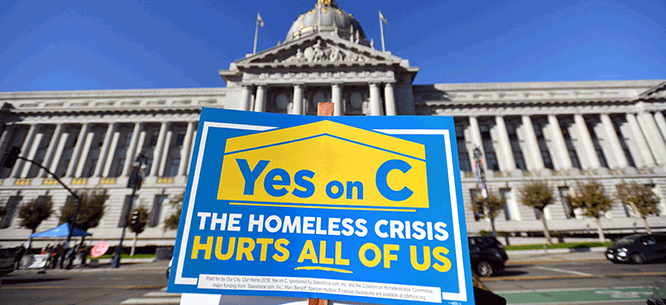Seizing the Initiative
Seizing the Initiative
Ballot initiatives led to progressive victories in unlikely places. The left should use them more often.

When we look back at the 2018 midterms, we will likely remember the historic victories of Alexandria Ocasio-Cortez, Ayanna Pressley, Rashida Tlaib, Ilhan Omar, and many others elected as part of the blue wave that helped retake the House of Representatives. And we should. Their elections signal resistance to Trumpism that we, the left, can build on.
But while we can and should focus on who we elect—particularly candidates like Ocasio-Cortez, who were put in office on the backs of mass movements—focusing solely on elected representatives puts far too much responsibility and stakes too much hope on them as individuals. Electing the right people is a start, but it is not enough. We should instead spend far more time on the ballot initiatives. Here’s why.
Ballot initiatives led to important progressive victories in the midterm elections. In Michigan, for example, voters not only legalized marijuana, they also voted to end gerrymandering—which should end the thirty-years-long conservative stranglehold on the state’s politics. In Florida, voters overwhelmingly approved Amendment 4, returning voting rights to approximately 1.4 million Floridians. In Massachusetts, voters made discrimination against transgender people illegal. Arkansas, alongside Missouri, increased the minimum wage. Idaho, Nebraska, and Utah all expanded Medicaid to cover more low-income citizens. On the local level, Baltimore City passed the first law in the country making water privatization illegal.
To be sure, the news wasn’t all good. Both Alabama and West Virginia passed legislation that could make abortions far more difficult to obtain, especially if the Supreme Court reverses Roe v. Wade. And Washington voters defeated an initiative that would have levied a carbon tax on corporations. But given the urgency of the current political moment, it’s worth thinking through the possibilities that ballot initiatives present.
First, ballot initiatives can transcend the restrictive limits of U.S. party politics. The two-party system is broken, but it is more or less baked in. And while a real left-wing insurgency has the potential to transform the Democratic Party, it is unlikely to turn the United States into a true multi-party democracy. Ballot initiatives, however, can sidestep the two-party stranglehold by going directly to voters and, in doing so, make the system more responsive to ordinary people. Michigan’s gerrymandering initiative stands out as an example. Parties rarely lead the charge against gerrymandering because they want the same power to strangle competition that the ruling party has, so in Michigan it was a twenty-seven-year-old woman, a political novice tired of seeing her vote wasted, who led the charge. Starting with nothing more than a Facebook account, she activated a groundswell that eventually organized 400,000 people.
Second, ballot initiatives can reduce the reach of corporate power. This may seem counterintuitive at first. Over the past four decades, corporations have accumulated increasingly greater power on the federal, state, and local levels, and they’ve used this power to enforce a bipartisan consensus that prioritizes private profits over the public good. Particularly at the city level, corporations have used this power to dodge taxes, privatize a host of services, and remake downtowns in their image. Ballot initiatives have been a part of this process. In Arizona, California, and elsewhere, chain retailers like Walmart and Target effectively used initiatives to dismantle local restrictions on big box stores. Corporations have also used their power to defeat initiatives that would affect them—during the midterm election, the parent company of one of Arizona’s largest energy suppliers spent approximately $25 million to defeat an initiative which would have required regulated utilities to garner at least 50 percent of their energy from renewable sources. Nevertheless, last week’s election showed how ballot initiatives—like the one recently passed in Baltimore that made water privatization illegal, or the one in Missouri that reversed the state’s right-to-work law—can stave off attempts to privatize public services and reduce labor power, and in doing so reverse the neoliberal assault on public goods and infrastructure. With the two parties largely unwilling to call explicitly for the kinds of structural changes that could adequately challenge corporate power, ballot initiatives can bypass the parties and take issues designed to curtail corporate power directly to the people.
Third, ballot initiatives develop political capacity. Whether in a medium-sized city like Baltimore or large states like California, the process of seeing a ballot initiative through from beginning to end—from deciding to put an initiative on the ballot to drafting the language to garnering the signatures to educating the public to mobilizing voters—teaches people about how political institutions function, how to communicate across demographic and political divides, how to organize communities, and how to navigate political bureaucracies. Successfully placing an initiative on the ballot takes a different skillset and mindset than those required for a direct action. Even unsuccessful ballot initiatives engage people in the mundane everyday activities of democracy—experience easily transferable to other issues and arenas. Furthermore, passing an initiative that demonstrably improves people’s lives can increase their desire to govern in as much as it shows that the tools of government can actually be used for good in ways they may have previously thought impossible.
Finally, ballot initiatives enable the creation of the type of cross-racial alliances needed to transform the state. Many have thought through the possibilities of a cross-racial class alliance in the wake of the 2016 election. However, the question of how to create the type of coalitions that flickered up in the Populist moment of the late nineteenth century is an important one, perhaps the most important one. Ballot initiatives like the ones used to expand Medicaid and end felon disenfranchisement are ones that can cause at least some of the individuals who voted for Trump to think of themselves and their interests in ways that transcend their party affiliation and, in some instances, their racial identity.
Ballot initiatives are not a panacea. A number of states used them to truncate rather than expand democracy. Corporations have and will continue to either use or block initiatives to maintain power. But if moving government leftward is part of our mission, growing a political movement from the bottom up will require ballot initiatives. The potential outweighs the perils.
Lester Spence is Associate Professor of Political Science and Africana Studies at Johns Hopkins University, where he is also co-director of the Center for Africana Studies. He is the author, most recently, of Knocking the Hustle: Against the Neoliberal Turn in Black Politics (Punctum, 2015).






